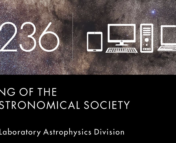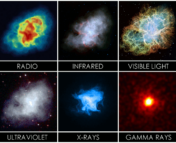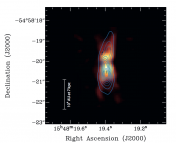Title: A Type II Radio Burst Driven by a Blowout Jet on the Sun
Authors: Zhenyong Hou, Hui Tian, Wei Su, Maria S. Madjarska, Hechao Chen, Ruisheng Zheng, Xianyong Bai, Yuanyong Deng
First Author’s Institution: School of Earth and Space Sciences, Peking University
Status: Accepted to ApJ [open access]
The Background
One of the most exciting qualities of the Sun is its magnetic activity that can manifest in a variety of ways and across the entire electromagnetic (EM) spectrum. X-ray photons reveal flares produced through magnetic reconnection, microwaves arise from synchrotron and gyrosynchrotron emissions from electrons accelerated along the Sun’s magnetic field, and low-frequency radio provides information on the plasma properties in the upper atmosphere of the Sun, called the corona. Magnetic activity also involves particle motion; plasma ejected by this activity can take many forms, and, if the plasma is energetic enough, it can escape from the Sun entirely as a coronal mass ejection (CME).
Because there are so many components to how magnetic activity manifests and evolves, it’s difficult to piece together a cohesive picture for how it all works. One phenomena that has eluded explanation for a long time is the origins of Type II radio bursts. Type II bursts are an example of plasma emission– emission from the coherent oscillation of electrons in a plasma that then produces coherent emission. Like laser light, the coherent emission is bright only at specific frequencies, namely, the plasma frequency, which depends on the plasma density. As the accelerator of the burst moves outwards through the corona, the ambient plasma density decreases and so the plasma emission frequency drifts to lower frequencies, giving Type II bursts a very distinctive “sweeping” signature in time-frequency space, as shown in the bottom frame of Figure 1.
For a long time, folks believed that all Type II bursts are associated with CMEs. This is because CMEs are one of the few phenomena from the Sun that are capable of generating the necessary shock in the corona for producing plasma emission. Producing a coronal shock requires moving faster than the Alfvén speed– which helps define the sound speed in a magnetized plasma– which can be 100s to 1000s of kilometers-per-second (km/s) in the Sun’s corona. However, there have been observations in recent years that suggest there are other processes on the Sun that can produce Type II bursts. This paper presents one such case, where the Type II burst may be associated with a jet instead of a CME.
The Events

Because different parts of the EM spectrum are sensitive to different components of magnetic activity, properly associating two events or phenomena with each other requires collecting simultaneous data across multiple instruments. Data from nine instruments were used in this study! A few of the major* contributors were:
1.) the Solar Upper Transition Imager (SUTRI), Atmospheric Imaging Assembly (AIA), and Extreme Ultraviolet (EUV) Imager (EUVI), all of which take pictures of the Sun at various EUV wavelengths and from different satellites,
2.) The Helioseismic and Magnetic Imager (HMI), aboard the same satellite as AIA, which is responsible for measuring the magnetic field of the Sun,
3.) the Geostationary Operational Environmental Satellite (GOES) for observing X-ray photons, and
4.) the Chashan Solar Radiospectrograph (CBSm), operating between about 100-500 megahertz (or about 1-3 meter wavelengths!)
The story of this event starts with AIA and SUTRI detecting a solar jet– a narrow burst of plasma from the Sun’s atmosphere– during its initial phase. During this phase, it moves about 370 km/s (about 1000 times faster than the speed of sound on Earth)! Soon after, a flare is detected in the X-ray by GOES, as shown in the middle frame of Figure 1. Following this, the jet’s velocity accelerates to 560 km/s and transitions to the ejection phase.

Things get extra interesting after the ejection phase has begun. At this point, AIA now detects a wave-like structure propagating through the Sun’s corona both in the same direction and at the same speed as the jet during its initial phase (see Figure 2). Not even a minute later, a Type II burst is detected by CBSm. By the time that the wave structure and the Type II burst are no longer detectable by their respective instruments, they are moving at the same speed (or somewhat faster than) the jet.
The Big Picture
The authors claim that the similarities of the jet, flare, wave structure, and Type II burst in terms of occurrence time, location, and speed suggests that the three phenomena are related to one another. The data paint a picture of a flare causing the eruption of material in the form of a jet. The jet excites the surrounding material as it moves through the corona, producing the EUV waves and the Type II burst. All of this happens without any evidence of a CME.
This is significant in several ways. It’s amazing a.) to have simultaneous data spanning so many observing methods and, by extension, b.) to be able to analyze the flare, bulk particle motion (the jet), and coronal excitation (the EUV wave and Type II burst) for a single event, and c.) to see a Type II burst without any evidence of a CME! This paper represents an exciting step towards understanding how our Sun’s activity, and the emission from it, are produced and evolve.
* Unfortunately, there’s not enough space in a single article to meaningfully reference all nine instruments and their results (although all were important). For those interested in the other instruments that were used, they were the coronagraphs COR2 on the STEREO satellite and LASCO on the Solar and Heliophysics Observatory satellite and the H-alpha imaging system on the New Vacuum Solar Telescope.
Astrobite edited by Lynnie Saade
Featured image adapted from SDO/AIA/NASA and V. Melnik




